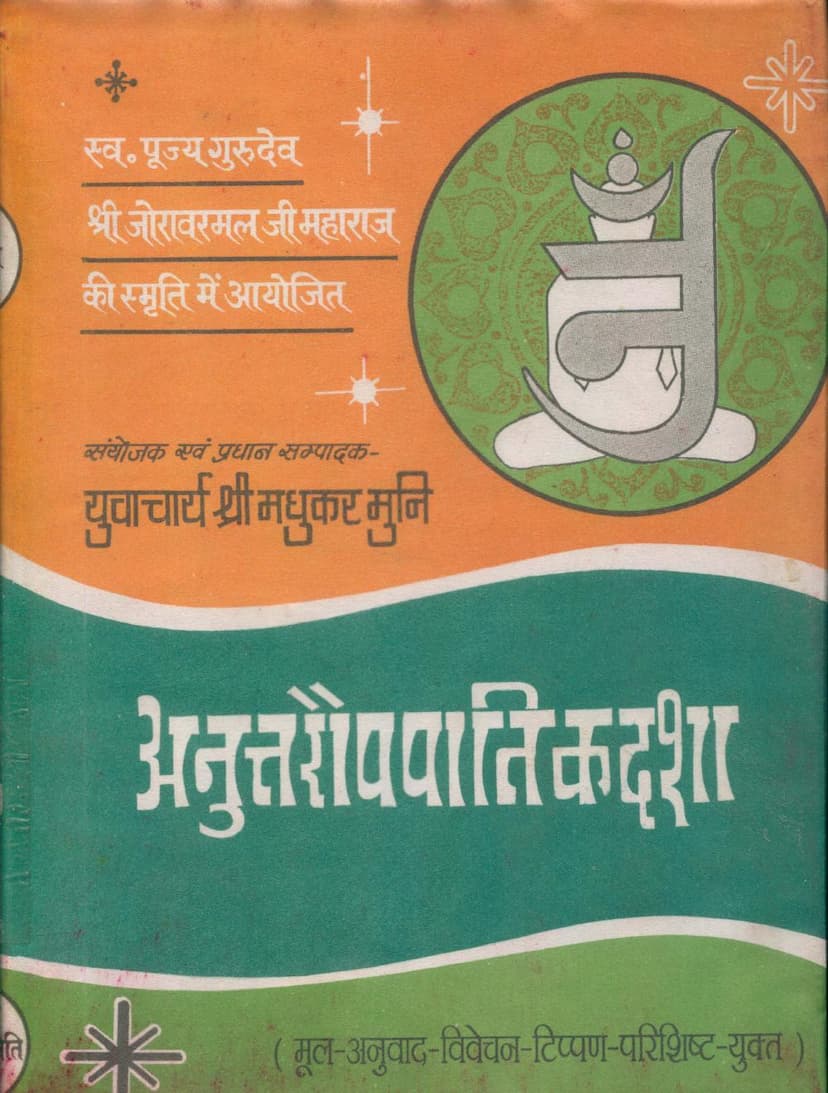Agam 09 Ang 09 Anuttaropapatik Sutra Stahanakvasi
Added to library: September 1, 2025

Summary
This document is a Hindi translation and commentary of the Anuttaraupapātikadaśā Sūtra, which is the ninth Anga (limb) of the Jain Agamas, compiled by the fifth Ganadhara, Bhagavat Sudharma Swami. The publication is brought out by Shri Agam Prakashan Samiti, Beawar, Rajasthan, in memory of Shri Joravarmalji Maharaj.
Here's a comprehensive summary of the key aspects presented in the document:
1. Title and Context:
- Book Title: Anuttaraupapātikadaśā Sūtra (अनुत्तरौपपातिकदशा सूत्र)
- Anga Number: 9th Anga of the Jain Agamas (Jinasāstra Granthamālā: Granthānka - 6)
- Author (Primary Compiler): Bhagavat Sudharma Swami (Fifth Ganadhara)
- Editor/Convener: Yuvaacharya Shri Mishrimalji Maharaj 'Madhukar' (Late)
- Translator/Annotator: Sadhwi Muktiprabha (M.A., Ph.D.)
- Publisher: Shri Agam Prakashan Samiti, Beawar (Rajasthan)
- Purpose: Published in remembrance of Rev. Guru Shri Joravarmalji Maharaj.
2. Core Subject Matter of the Anuttaraupapātikadaśā:
- The Sūtra describes the lives of great souls (maha-purushas) who, through intense asceticism and vows, achieved rebirth in the Anuttara Vimanas (unexcelled celestial abodes).
- These beings are called Anuttara-upapātikas because they are born in these superior celestial realms.
- The ultimate goal for these beings is to attain Moksha (liberation) after their lifespan in the Anuttara Vimanas is over, by taking birth in noble human families.
- The Sūtra aims to demonstrate that the pursuit of worldly pleasures (kāma-bhoga) is not the ultimate goal of human life; rather, striving for Paramanishreyas (ultimate liberation or Moksha) is the true success.
3. Structure of the Sūtra:
- The current text is divided into three Vargā (sections).
- The first Varga contains 10 Adhyayanas (chapters).
- The second Varga contains 13 Adhyayanas.
- The third Varga contains 10 Adhyayanas.
- In total, the Sūtra describes the lives of 33 great souls.
4. Key Individuals and their Stories:
- First Varga: Focuses on 10 princes, sons of King Shrenik (including Jāli, Mayāli, Upajāli, Purushasen, Varishen, Dirghadant, Lashṭhadant, Veḥalla, Vehāyas, and Abhayakumār). It details their noble lives, adherence to asceticism, rebirth in Anuttara Vimanas, and future attainment of Moksha.
- Second Varga: Describes the lives of 13 princes, also mainly sons of King Shrenik and Queen Dharini (including Dirghasen, Mahasen, Lashṭhadant, Gūḍhadant, Shuddhadant, Halla, Drum, Drumsen, Mahādrumsen, Singh, Singhsen, Mahasinghsen, and Punyasen). Their stories are presented concisely, highlighting their ascetic practices leading to Anuttara Vimanas.
- Third Varga: Narrates the lives of 10 individuals, including Dhanyakumār (who is described in detail), Sunakshatra, Rishidās, Pellaka, Rāmaputra, Chandrika, Pṛṣṭhimātrika, Peḍhālaputra, Poṣṭilla, and Veḥalla.
- Dhanyakumār: Son of Bhadrā Sārthavāhī from Kākanandī. He lived a life of immense luxury but was inspired by Lord Mahāvīr's teachings to renounce the world. His ascetic practices, particularly his vows of fasting (ṣaṣṭha), abstaining from desire for even simple food (āyāmbil), and his extreme emaciation due to severe penance, are described vividly with numerous similes. He achieved rebirth in the Sarvārthasiddha Vimana and will attain Moksha from Mahāvideha Kṣetra. His story emphasizes the power of renunciation and rigorous asceticism.
- The text also briefly mentions that Dhanyakumār's lineage might be traceable to King Shrenik. The stories of other individuals in this Varga are generally similar in theme to that of Dhanyakumār and Jālikumār.
5. Historical and Cultural Significance:
- The Sūtra provides valuable insights into the socio-historical conditions of ancient India, particularly during the time of Lord Mahāvīr and King Shrenik.
- It mentions King Shrenik of Magadha, his queens Dharini and Nanda, and his various sons, connecting them with Jain and Buddhist traditions.
- The detailed descriptions of wealth, customs, and the lives of princes highlight the societal structures of that era.
- The text also discusses the concept of "kala" (arts and sciences) that princes were educated in, listing 72 such arts in the case of Dhanyakumār.
6. Jain Asceticism and Philosophy:
- The Sūtra strongly emphasizes the importance of Tapas (asceticism) as the primary means to purify the soul and overcome karmic bondage.
- It describes various forms of fasting and austerity, highlighting the dedication of the individuals towards achieving liberation.
- The concept of Samlekhana (ritualistic fasting leading to death) is presented as a disciplined and conscious act of renunciation, distinct from suicide.
- The text underscores the Jain principles of Samyaṁ (restraint), Gati (conduct), and Darśan (right perception) as essential for spiritual progress.
7. Textual Matters and Variations:
- The text acknowledges variations in manuscripts and earlier traditions regarding the names of the individuals and the number of Adhyayanas, as noted by commentators like Acharya Abhayadev Suri.
- The Sūtra's language is generally described as simple and accessible, though it contains profound philosophical and historical content.
8. Publisher's Note and Editor's Preface:
- The preface highlights the importance of the Agamas as the source of Jain philosophy and ethics.
- It traces the history of the preservation and transmission of the Agamas, from oral tradition to being transcribed and later printed.
- It acknowledges the significant efforts of various scholars and monks in bringing out these Agamas for the benefit of the public.
- The publication itself is presented as a continuation of the commendable work of disseminating Jain scriptures.
9. Appendices and Glossary:
- The book includes appendices with "Tippaṇ" (Notes) explaining specific terms and concepts, a glossary of technical terms ("Pāribhāṣik Śabdakoṣa"), and lists of verbs ("Kriyā-Pad-Saṅkalanā") and indeclinable words ("Avyaya-Pad-Saṅkalanā").
- The "Tippaṇ" section provides detailed explanations of locations (like Rajagriha, Kākanadī, Sahasrāmravana), historical figures (Shrenik, Dharini, Meghakumār, Gautam Swami, Skandak, etc.), and Jain concepts (like 'ṣaṣṭha', 'āyāmbil', 'samādhi', 'tapas').
- The detailed appendices and glossary are crucial for understanding the nuances of the Sūtra.
In essence, the "Anuttaraupapātikadaśā Sūtra," as presented in this volume, serves as a testament to the spiritual heights attainable through rigorous asceticism and detachment, leading to a favorable rebirth in higher realms and ultimately to liberation, serving as an inspiration for spiritual seekers.